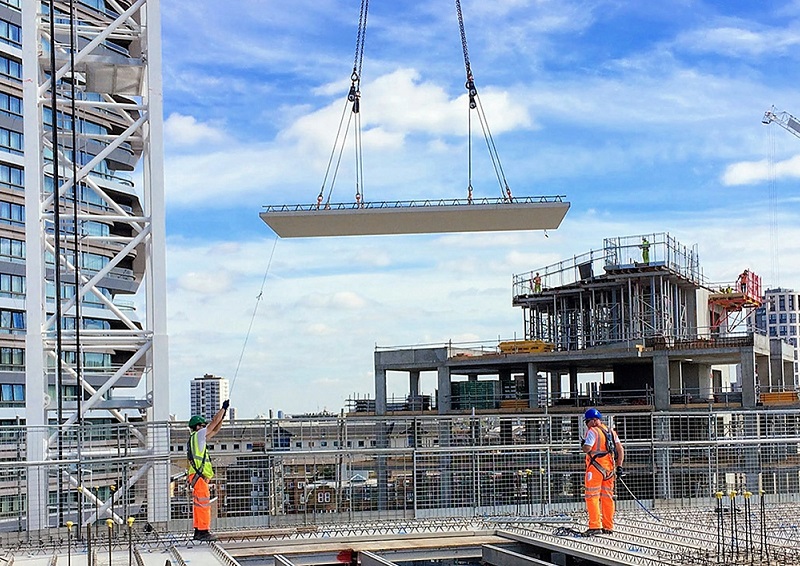Construction site
A construction site is an area or piece of land on which construction works are being carried out.
The term ‘building site’ is often used interchangeably with construction site, although this tends to indicate that buildings (and sometimes, more specifically, housing) are being constructed, whereas the term ‘construction site’ can refer to all types of works, such as road construction, sewer construction, landscaping, and so on.
The CDM Regulations suggest that a construction site: '...includes any place where construction work is being carried out or to which the workers have access, but does not include a workplace within the site which is set aside for purposes other than construction work.'
Typically, land will become a construction site when it is handed over to a contractor to begin the construction works. Regulation 6 of the CDM regulations requires that notice is given to the Health and Safety Executive (HSE) as soon as is practicable before the construction phase begins. On projects involving more than one contractor, the CDM regulations also require that the client appoints a principal contractor to co-ordinate the construction phase.
In the first phase of the works, construction may be restricted to preliminary activities such as; securing the site, site clearance, setting up site facilities, demolition, groundworks, and so on. It is often apparent that a site has become a construction site when hoarding is erected to secure its perimeter.
It is relatively common for sites to remain in this 'prepared' condition for some time with little evidence of further construction works being undertaken. This may be due to complexities in securing all the land required, obtaining permissions, securing all the funding required, complex ground works, ongoing design, and so on. This can leave developers open to accusations of landbanking.
Once above ground works begin, construction sites may appear to progress relatively quickly as structural frames grow and cladding is installed. They may then appear to slow again as internal fit outs are undertaken and finishing work is carried out.
Typically, a construction site will revert to being a non-construction site when it is handed back to the client on certification of practical completion. However, there may be ongoing minor works required to rectify any defects that become apparent.
NB The Scottish Building Standards, Part I. Technical Handbook – Domestic, Appendix A Defined Terms, defines site in relation to a building as: ‘…the area of ground covered or to be covered by the building, including its foundations.’
On Designing Buildings Wiki, there is a range of useful information relating to construction sites, including:
- Access to construction sites.
- CDM.
- Complaining about construction sites.
- Condition survey.
- Development footprint.
- Ground conditions.
- Handover construction site to the client.
- Handover to the contractor.
- Hoardings.
- How to work safely on a construction site in the dark.
- How to work safely on a construction site in winter.
- Injuries on construction sites.
- Landbanking.
- Lighting of construction sites.
- Logistics.
- Mobilisation.
- Notifiable project F10 form.
- On site.
- Possession.
- Perimeter security.
- Plot.
- Reporting accidents and injuries on construction sites.
- Site appraisals.
- Site area.
- Site facilities.
- Site induction.
- Site layout plan.
- Site office.
- Site plan.
- Site safety.
- Site storage.
- Site survey.
- Temporary site services.
Featured articles and news
Latest Build UK Building Safety Regime explainer published
Key elements in one short, now updated document.
UKGBC launch the UK Climate Resilience Roadmap
First guidance of its kind on direct climate impacts for the built environment and how it can adapt.
CLC Health, Safety and Wellbeing Strategy 2025
Launched by the Minister for Industry to look at fatalities on site, improving mental health and other issues.
One of the most impressive Victorian architects. Book review.
Common Assessment Standard now with building safety
New CAS update now includes mandatory building safety questions.
RTPI leader to become new CIOB Chief Executive Officer
Dr Victoria Hills MRTPI, FICE to take over after Caroline Gumble’s departure.
Social and affordable housing, a long term plan for delivery
The “Delivering a Decade of Renewal for Social and Affordable Housing” strategy sets out future path.
A change to adoptive architecture
Effects of global weather warming on architectural detailing, material choice and human interaction.
The proposed publicly owned and backed subsidiary of Homes England, to facilitate new homes.
How big is the problem and what can we do to mitigate the effects?
Overheating guidance and tools for building designers
A number of cool guides to help with the heat.
The UK's Modern Industrial Strategy: A 10 year plan
Previous consultation criticism, current key elements and general support with some persisting reservations.
Building Safety Regulator reforms
New roles, new staff and a new fast track service pave the way for a single construction regulator.
Architectural Technologist CPDs and Communications
CIAT CPD… and how you can do it!
Cooling centres and cool spaces
Managing extreme heat in cities by directing the public to places for heat stress relief and water sources.
Winter gardens: A brief history and warm variations
Extending the season with glass in different forms and terms.
Restoring Great Yarmouth's Winter Gardens
Transforming one of the least sustainable constructions imaginable.
























Comments